Blog Archives
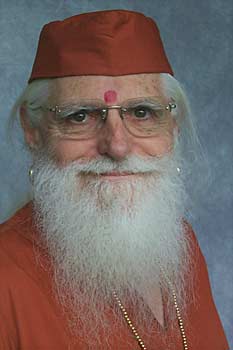
We hope everyone has been reading the lesson of the day, as we are in the middle of some of the most wonderful lessons about the soul and the soul body… it only reminds again what a Rishi was our Gurudeva!
Be patient … we have 33 photos today from our Sivaratri celebrations both here and in Mauritius.
And for those whose only audio option is “Real Audio” we are happy to say that the problems with the audio files since the 7th have been resolved and you may go back to listen to those talks now if you wish to. They will work now.
Our Beloved and Revered Satguru Sivaya Subramuniyaswami
Attained Maha Samadhi on November 12th, 2001
Click to read for Details.
Click here to read
Gurudeva’s statement on September 11th
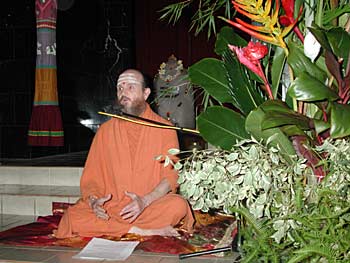
On the last night of last phase we observed Maha Sivaratri festivities here at Kadavul. Bodhinatha gave a wonderful talk on Lord Siva and also the difference between the worship of Lord Muruga and the worship of Lord Siva.
Cybertalk: We received some feedback on the last talk on words that hurt.
Many found that teasing and joking definitely don’t pass the tests. Good
motive, but flawed method. How do we lighten things up otherwise? Watch a
comedy, read a humorous book, play noncompetitive sports, walk in nature,
watch the sunrise and sunset together, do something enjoyable like planting
things, talk about something different and light, like cooking.
Cybertalk Ends”
For more information about listening to Gurudeva’s talks online and to hear them in other formats, click here.
And click here for an Index to All Past CyberTalks.
Study Gurudeva’s teachings
every day. Visit the Master Course site!
Bodhinatha will be happy to hold “Prasnottara Satsang” — “Questions and Answers” over the telephone with any Hindu religious societies, Hindu youth groups, Radio talk show hosts etc. All you need is a phone with a speaker and an enthusiastic audience. Arrangements may be made in advance by sending email to Sadhaka Mahadevan
If you are experiencing any problems listening to the audio, please to go our Audio FAQ page for sound geeks and follow the directions there.
 |
|
|
 |
||
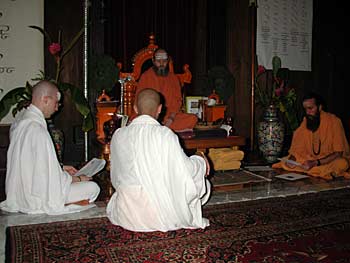
The evening began at 7:00 PM with devotees in the temple singing bhajans while the monks observed the auspicious occasion of two Sadhaka taking their next step into monastic life to become Yogis. Sadhaka Japendranatha and Sadhaka Mahadevan have requested and been accepted to take up the staff of the Yogi Tapasvin… Acharya Kumarswami administers the vows with Bodhinatha presiding.
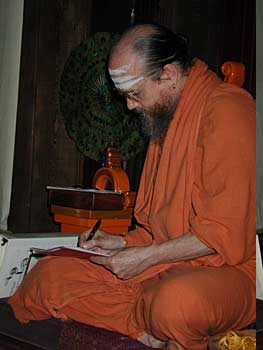
Bodhinatha signs the vows of the two new yogis. This stage of monastic life can be taken by those who may qualify (though it is not guaranteed) to take lifetime vows of sannyasa in the future.
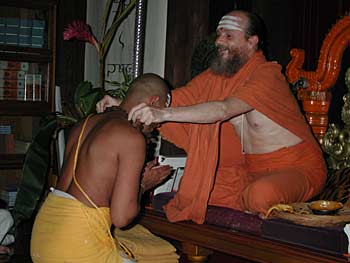
Both receive new vestments: yellow robes, the yellow pulnool, the staff of tapas and new guidelines for monastic life which include, for example, spending more time in their Raja Yoga pursuits of concentration, meditation and contemplation toward Self Realization.
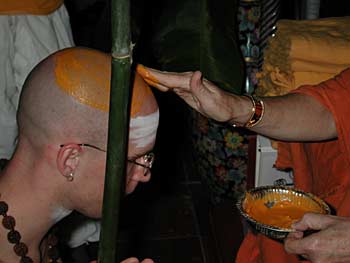
Bodhinatha blesses our new Yogis with chandanam paste (sandalwood).
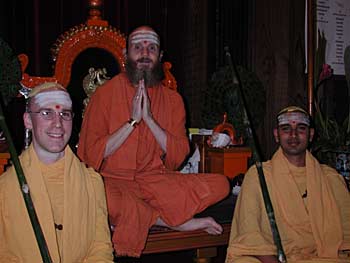
They both left the room to change into their new robes and returned for a photo… We are proud of both Yogi Japendranatha and Yogi Mahadevan for their exemplary conduct during their monastic life so far and pray to Lord Murugan to raise the fire of kundalini to lead them upward and inward to merge with Siva. Gurudeva must be very happy to be watching this from the inner worlds.
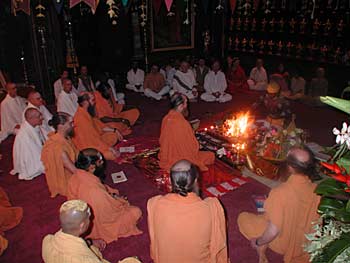
We all adjourned to Kadavul temple for the evening’s worship.
This photo was from Sivaratri night, but it reminds us of one of the subjects of Bodhinatha’s talk today (Sun One) on Satsang… He explained the importance of satsang in helping us to stay in our higher nature. “Good Company” is an old teaching…but Bodhinatha bids us beware of the pitfalls of backbiting when a group is formed and some individuals take pleasure in discussing the faults of others in the group, which is a destructive habit pattern we want to avoid.
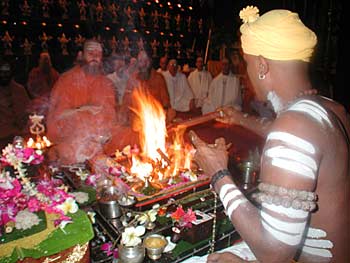
The sacred fire received many prayers….
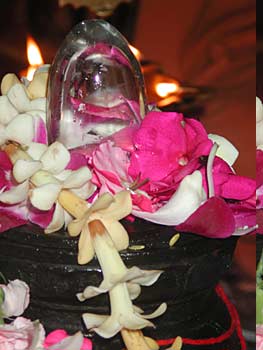
This is a close up of a spatika (crystal) Sivalingam that was adjacent to the homa fire.
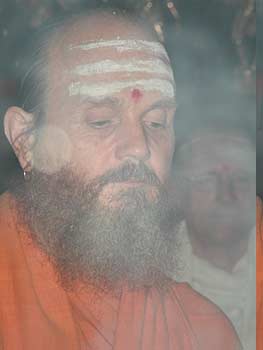
It is the beauty of Saiva Siddhanta that we have our sacred Agamic rites and simultaneously the mystical knowledge of monism… thus worship in the temple becomes also a deeply introspective experience at the same time as we are worshiping outwardly.

Everyone stands reverently as the arati to the fire is waved.
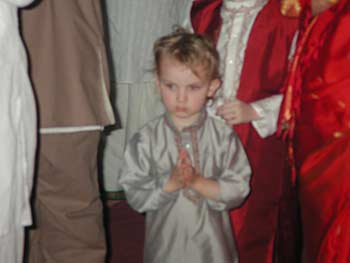
Our bright young Jayendra, though it was late, was very attentive. A lucky soul to be here at Kadavul on this special Maha Sivaratri day.

The implements for offering ghee to the homa fire: One is a wooden “spoon” with a deep well that will hold clarified butter which pours out the mouth of the cow onto the flame. On top is another spoon, simply carved…used to hold the banana and betel leaf and flowers which are offered together into the fire as the final “Purnahuti.”

The ghee makes the fire to blaze… it is said that the smoke from the offerings made during the Vedic rites purifies the atmosphere, nourishes the spirits and brings peace and harmony to the surrounding community.
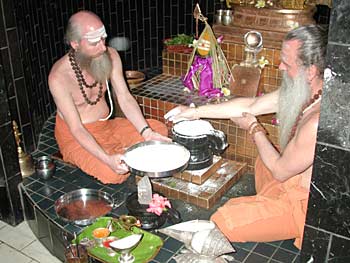
We proceeded from the homa to the abhishekam. Paramacharya Ceyonswami and Paramacharya Palaniswami offer the holy ashes to the Siva lingam.

In turn, pairs of the Saiva Swami Sangam come forward to offer the milk abhishekam to the Sivalingam. Meanwhile others are chanting Sri Rudra. This is always a very profound moment. Above us on the gold tiled platform is Lord Nataraja, six-feet tall and not to be photographed.
Jai Mahadeva! Jai Maha Sivaratri!
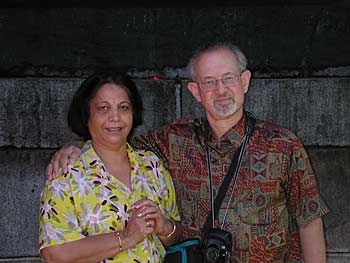
Today was Sun One and we had some wonderful guests from Toronto, Canada.
 The Remarkable Vision |
Iraivan Temple Progress Update |
Join this historic undertaking. Please contribute generously. Sponsor a stone today! |
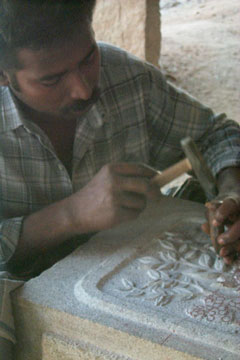
We bring you more photos of the “incredible pillar carving project” from Bangalore. Here the final intricate work is being done on a design of sacred plant leaves.
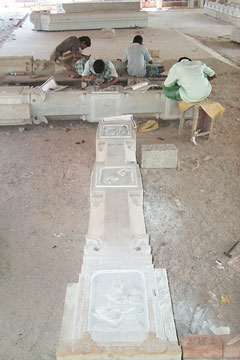
Many pillars are being worked on at once.

We are please to announce a new page at our Iraivan Temple web site where you may see what kinds of participation are available and also from there you may go to a secure donation page to make a donation directly on the web. Your credit card information will be secure. Please make a love offering today! Go to “Help and Giving”
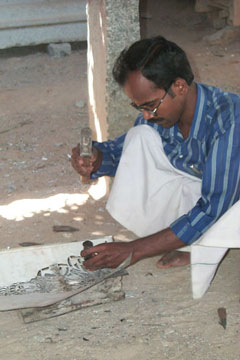
Here we see the initial process of transferring a drawing to the stone by tapping over a drawing with charcoal on it which transfers the black markings to the stone.
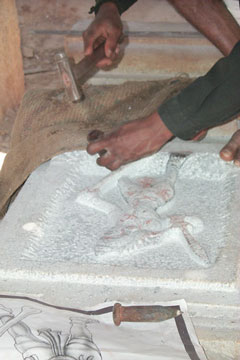
This is intricate work and we have asked the carvers to do it in deep relief to give a very visible result.
Break Through in Trinidad
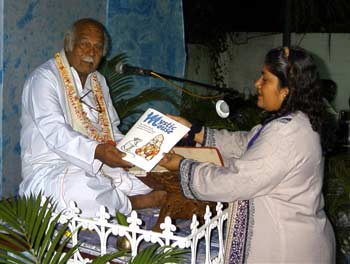
An historic event recently took place in Trinidad. There, Kashika Publications has printed and released the very important children’s course called “Mystic Mouse, the Hindu Interactive Color Book” which is a illustrated rendition of Gurudeva’s teachings from Merging with Siva. This is a major breakthrough as Kashika Publications now comes on board as our fourth “off shore” publisher, reprinting Gurudeva’s works, in line with the prestigious Motilal Benarsidass in New Delhi, Sophia Publishing in Kiev, Ukraine, and Uma Publications in Malaysia. It is also a boon for all those around the world clamoring for works they can use to present the Sanatana Dharma to children and youth. (adults love this book also!) This work was the inspiration of Pundit Narendra Ragoonanand and his wife Ashwinee who have been agressively and with great inspiration distributing Gurudeva’s teachings in Trinidad for many years. They are amazing sevaks in their dedication of time and energy.
Ashwinee writes: “The Mystic Mouse was launched on Saturday March 9th, 2002 at the Hari Mandir Tunapuna, at the residence of Pundit Lutchmee Persad. This day was choosen to coinside with the Vijaya Akaadashi and the first day of Siva Puran reading in observance of Maha Sivaratri. The Nine Beliefs of Hinduism was also launched in it’s new poster size framed edition.
Here, Ashwinee presents the first copy of Mystic Mouse to Pundit Lutchmee Persad.”
Watch here for details on acquiring this for your children.
Gurudeva’s spiritual center in the island country of Mauritius
in the Indian Ocean near South Africa
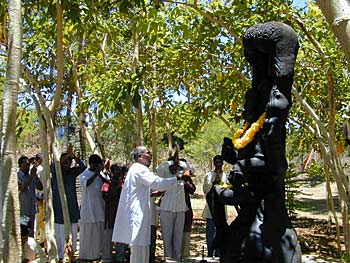
Mahasivaratri, the Great Night of Siva, is the most celebrated Hindu festival in Mauritius. Hindus of all ethnic and religious denominations worship Lord Siva on that occasion. In the island, for Hindus of north Indian origin, Mahasivaratri is synonymous of a foot pilgrimage to the sacred lake of Grand Bassin, now named Ganga Talao. Hundreds of pilgrims would go to Ganga Talao to bring the sacred water that they would ceremoniously pour on the Sivalingum on their return at their local temples. Here we see a group of devotees worshipping at the SivaDhakshina murthi in the little Konraii grove at the Spiritual Park.

One very popular and beautiful aspect of the Mahasivaratri pilgrimage is the kanwar, a wooden structure decorated with pieces of white cloth, mirrors and colorful ribbons which the pilgrims carry as a form of penance. Some kanwars are small and are carried by one pilgrim only, while others are very large and are carried all through the pilgrimage by several pilgrims. Most of the kanwars often look like small Siva temples and there is often an altar installed inside with the murthi of Lord Siva. Thus Siva is always worshipped with an arthi all the way from the lake to the home town.

Some of these kanwars are constructed with creative imagination, like the one here, where we have also Lords Ganesha and Muruga….
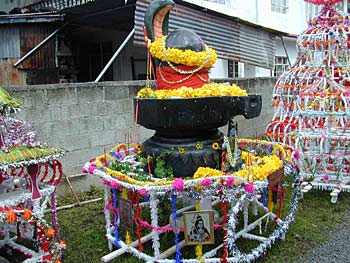
Here is a beautiful kanwar in the form of the Sivalingum and made of very light material. Gurudeva explains that the Sivalingum is the most prevalent icon of Siva. This icon is the simplest and most ancient symbol of Siva, especially Parasiva, God beyond all forms and qualities.
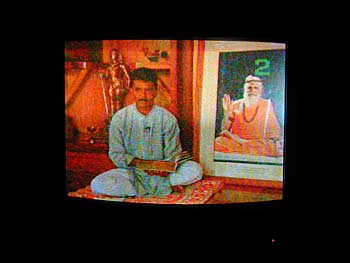
Both the Mauritian public Radio and Television stations would broadcast programs items related to Mahasivaratri for a whole week preceding this great Saivite festival. Here is Rajen Manick of the Himalayan Academy reading portions of Gurudeva’s Dancing with Siva in French in one such TV programs.

|
Study Gurudeva’s teachings.
|
transcription begins
Date: March_08_2002
Title: The Need for Religion Part 1
Category: God and Lords of Dharma
Duration: 13 min., 38 seconds
Date Given: February 10, 2002
Given by: Bodhinatha
Today in the drawing from the ‘Lesson of the Day’. It seemed particularly relevant.
It starts out, “What are the differing views on evil?” We hear lots of talk about evil these days. Usually it is talking about Osama Bin Laden, something like that. President Bush loves to talk about evil. It is on evil. It is very interesting if you think about it. “For monistic theists, the world of maya is Siva’s perfect creation containing each thing and its opposite. For pluralistic theists, the world is tarnished with evil. Thus maya could not be a creation of a perfect God.” Look there, even in Saiva Siddhanta we have one school believing in evil.
There is a wonderful statement by Chellappaswami that I was drawn to this morning, “Oru pollappum illai. There is not one wrong thing.” Not one wrong thing. I was reading. I found this and wanted to write the Tamil script and copied it from the introduction from Sandaswami’s introduction in ‘Natchintanai’ and he reminded me that Chellappaswami would choose a Mahavakyam, a great statement like this and utter it for a year. Just keep saying it over and over and over again and reflecting upon it for a whole year.
What does that show us? It shows us maybe this statement is worth thinking about! Maybe there is more to it than meets the eye. Of course, we can apply it to the world when we say there is not one wrong thing. Whatever happened was destined to happen because of what happened in the past. The present is the effect of a previous cause, as Gurudeva says in describing karma. This is the effect of a previous cause and the previous cause was the effect of a previous cause and that previous cause was the effect of a previous cause and so forth. Whatever happens in the present was created in the past. So, to really be content with what is going on in the world, no matter how problematic, how difficult, is what this is about. Quite often, we are influenced, particularly when other people are influenced. We talk to them and they are all depressed, discouraged and afraid. We talk to them and we pick that up more than we realize. It influences our state of mind, it influences our perspective on life. It influences our long term plans, all of a sudden they get shorter. Why? Because we are dealing with people who have been significantly influenced by the events of the world. They are definitely worried, afraid and they see evil. They don’t like to see evil.
So, “Oru pollappum illai. There is not one wrong thing.” To really look at the world that way is a wonderful relief. Nothing wrong, everything is perfect. Everything is as it should be because that is what got created by what happened before. Not because it is the ideal that somebody wanted. But we all create it by what we did before.
It is good to reflect and look at our own thinking. Make sure we are not being unduly influenced by others who are reacting negatively and to keep our long term plans long, maybe even make them longer. Add a few more years on. Remember that life is what we make it. We create our future by how we act in the present.
Thus looking at the world we can also look at our own life. Apply this same idea, that there is not one wrong thing to our own life.
Recently, a number of devotees have mentioned difficult situations at work, of one kind or another. Having trouble dealing with a supervisor who is not at all religiously minded. Kind of low-minded person, gives them a difficult time, is constantly throwing them off center. They are in a situation at work where they are not being treated justly. Others are being favored, somehow they are getting unfavorable treatment. It is not a just situation.
Of course in that situation, what is easy to do? It is easy to feel that something is wrong. Right? “This is not how it should be. I should not be treated unjustly. It is not fair.” Right? Wrong. Of course, we should be being treated unjustly if we are being treated unjustly because that is our karma. Right? We couldn’t possibly be treated unjustly if it wasn’t our karma to be treated unjustly. It just doesn’t happen. There is not one wrong thing. So anything that happens in our life that we don’t accept, that we feel should be otherwise, we are making it a wrong thing. We are saying life should not be treating us this way. This person should not be treating us this way, this should not be happening, this is a wrong thing.
Chellappaswami’s sage advise is – Don’t look at it that way. It is a right thing. Why is it right? Not because it is ideal but because we created it by our own past actions. Everything we face, we created. Looking at it as a wrong thing, wishing it would not happen might be prolonging its happening because we are not accepting it, not letting it go. If we can look at it in a way that, “Gee, I am being treated unjustly. How interesting! Who was I unjust to in a past life, I wonder! How many times was I unjust in a past life? Maybe I am being unjust to somebody in the present life. Maybe I haven’t changed. Maybe I better think about that. Maybe I better be a little more just to everyone else just to be sure that I don’t create this again in the future, once the current situation goes away.”
So, we can reflect and use this wonderful principle, to be self-reflective upon what we have created in the past. Make sure we are not creating it again for the future, because we just might be.
The greatest example there was Swami Sivananda when he was attacked unjustly by someone in his ashram. Of course, as we know the story, he went the next day to the jail and garlanded the person and thanked him for bringing that karma back to him. Playing it out, getting rid of it. Maybe that was his last karma on the planet. That one came back and he was so happy, he said, “Oh, this is wonderful. I am so glad this person was unjust to me.”
How many of us are able to say that when that happens? “I am so glad this person was unjust to me. I got rid of that karma. Because, there is not one wrong thing.”
Anyway, we can see that it is a very profound statement and certainly worth repeating for a few years!
The next part of today’s lesson is on ‘Vedanta and Religious Unity’. The text focuses on how the truths of the Upanishads, the Oneness of God and man, is presented sometimes without getting into any particular religion. It sounds like anyone can successfully grab onto one of the yogas – karma yoga, bhakti yoga, raja yoga, jnana yoga – and realize God. No problem, yoga and Vedanta.
Gurudeva points out that it does not necessarily work that way. There is a need for religion. As many of us know, who have been with Gurudeva for a long time, when Gurudeva first taught us, he taught us meditation. Focused on realization, meditation, seeing our inner light, going deeper and the monks realizing Parasiva. Then, something changed. He started teaching us devotion. All of a sudden, we were building temples, spending time in New York across the street from temples. Temples were important and Ganesha was everywhere.
What changed? Gurudeva realized that his devotees needed a foundation of devotion. To pursue meditation without a foundation of devotion might not bear fruit. Why is this? Because life throws us off center, because we have ups and downs. We have difficult times. Things don’t always go well for us. We get upset. People we love have problems and so forth. Life can be very disturbing. So, if your only practice is meditation, it doesn’t always work. It doesn’t always work. Karma can be rough and get impossible to meditate. If your only practice is meditation, what happens when you cannot meditate? You are in trouble. You don’t have anything else. You have nothing to fall back on. You have no foundation. You might get very depressed and go down in consciousness because your one religious practice doesn’t work anymore.
One of the reasons Gurudeva brought forth devotion, is that it gives us something to fall back on if we cannot meditate. It is like the tight rope walker and the safety net. It gives us a safety net, so we don’t hit the ground and break a leg or something. If we can’t pursue what we are pursuing successfully, devotion always works. A net of devotion catches us from falling into a lower state of mind, a depressed state of mind, a suicidal state of mind. We are always caught by the net of devotion. We don’t get anywhere near those negative areas. So it provides a wonderful stabilizer on the path. It keeps the emotions from swinging all over the place, the moods from swinging all over the place. One of the problems if you don’t have that is you can have a really, really wonderful meditative experience, go very, very deep in consciousness and then go the opposite way, go down in consciousness just as far as you went up, if you don’t have stability.
So Gurudeva brought us all into devotion and that is one of the reasons.
transcription ends
|
MORE UPLIFTING THINGS |
Innersearch 2002 in Hawaii!
Our next Innersearch Travel-Study program will be held right here on the island of Kauai in the summer of 2002. It’s the first such program on the Garden Island since 1974! From July 17 to July 22 we will enjoy daily classes with the swamis, join in the annual Guru Purnima festival, be inspired by local culture, explore the lush tropical island in exciting and non-touristy ways, and more. Be prepared for a wonderful spiritual experience in paradise with meditations, seminars and sacred ceremonies at the Siva temple of Kauai’s Hindu Monastery. Many have applied already, and there is a limit of 50 participants, so we recommend everyone apply as soon as possible. Interested? Please request an application from pilgrim@searchbeyond.com |
|

|
Check our children and youth section for new items for the young and young at heart! | |
|
1. SIGN OUR GUESTBOOK and receive a FREE GIFT |
||
| 2. Newest Book: LIVING WITH SIVA | ||
|
3. Visiting KAUAI’S HINDU MONASTERY |
||
|
4. Contribute to THANK YOU, GURUDEVA FUND |
||
From Our Gurus' Teachings
Archives are now available through 2001. Light colored days have no posts. 1998-2001 coming later.
